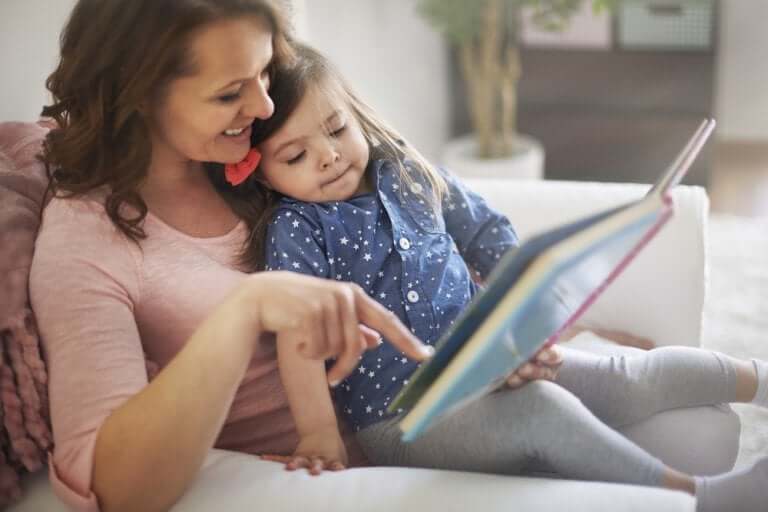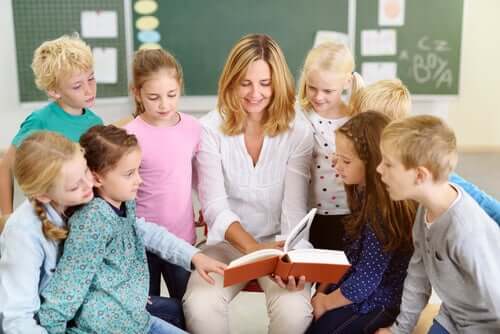The Educational Value of Stories for Children


Written and verified by the pedagogue and trainer María Matilde
We can’t deny the important teaching value of stories. They’re an excellent resource that promotes the taste for reading, and develops people in so many ways – from an early age right through to adulthood.
When they’re young, children encounter their first imaginative experiences in storybooks. These books satisfy their insatiable curiosity and, as a result, connect images and words to their sensations.
Stories and their characteristics
According to Gianni Rodari, a story can be defined as a short, simple and linear account. This can be either oral or written, and real or imaginary. It has a simple plot with a short description of the setting and a small number of simple, and not overly developed characters. The purpose of the stories is usually moral or recreational.
The structure of a story is shaped by the presentation of its characters and the description of a specific situation or conflict. This situation or conflict must be solved by the intervention of the different characters, and then move towards its final outcome.

The main characteristics of a story
- Allows you to develop the imagination
- Awakens emotions and feelings (joy, anger, sadness, admiration)
- Combines reality with fantasy
- Transmits values (goodness, justice, respect, loyalty, compassion, solidarity, friendship, overcoming)
- A resource to reflect on behavior, and what is right or wrong
- Enables conflict resolution and thus reduces fear
The educational value of stories
Stories have tremendous educational value. Their pedagogical and didactic benefits include the following aspects:
- Allowing the transmission of cultural heritage
- Promoting language development
- Benefiting a child’s psychological development
Listening to stories, and also reading them, allows children to expand their vocabulary and ways of expressing themselves. They can also make progress in their understanding of increasingly complex forms of written texts.
At the same time, it favors their cognitive development, allowing them to apply the situations experienced in stories to what they experience in their daily lives.
In addition, stories can be very beneficial for children in:
- Exercising their memory capacity
- Improving their attention span
- Improving their concentration
- Helping them to order events that have a definite beginning and end
At an emotional and social level, stories help them to understand the meaning of certain values through both the positive and negative actions of the characters in the stories. Through this, they gradually learn and accept certain social roles and norms.
On a psychological level, through the stories, they can see themselves and their own situations in the lives of the characters, and thus identify with them. A story can allow both children and adults to find answers to their fears, needs, and conflicts.

In short, when they’re adapted to the ages of the children and their educational capacities, stories satisfy their desire to know more and more, whether about contexts, people, situations, or sensations.
The importance of storytelling
It’s important, especially when dealing with children, to know the difference between telling a story and reading it. When we tell a story, you create a beautiful setting, attract children’s attention, and invite them to enjoy the story and its characters. To do so requires acquiring certain skills.
To tell a story well, you should modulate your voice well and speak calmly and slowly. You’ll need to imitate the tone and voices of the characters and have the necessary pauses and silence as required by the plot.
It’s also important to be near the listeners and to be at their level. With children you simply need to create an atmosphere of complicity and trust.
A story is…
…a journey into the unknown, a journey along a path that invites you to discover and investigate, while growing and progressing at the same time. A story is essential for a child’s emotional, intellectual, and linguistic development. This also applies to the “older children” among us! This is the true educational value of a story.
We can’t deny the important teaching value of stories. They’re an excellent resource that promotes the taste for reading, and develops people in so many ways – from an early age right through to adulthood.
When they’re young, children encounter their first imaginative experiences in storybooks. These books satisfy their insatiable curiosity and, as a result, connect images and words to their sensations.
Stories and their characteristics
According to Gianni Rodari, a story can be defined as a short, simple and linear account. This can be either oral or written, and real or imaginary. It has a simple plot with a short description of the setting and a small number of simple, and not overly developed characters. The purpose of the stories is usually moral or recreational.
The structure of a story is shaped by the presentation of its characters and the description of a specific situation or conflict. This situation or conflict must be solved by the intervention of the different characters, and then move towards its final outcome.

The main characteristics of a story
- Allows you to develop the imagination
- Awakens emotions and feelings (joy, anger, sadness, admiration)
- Combines reality with fantasy
- Transmits values (goodness, justice, respect, loyalty, compassion, solidarity, friendship, overcoming)
- A resource to reflect on behavior, and what is right or wrong
- Enables conflict resolution and thus reduces fear
The educational value of stories
Stories have tremendous educational value. Their pedagogical and didactic benefits include the following aspects:
- Allowing the transmission of cultural heritage
- Promoting language development
- Benefiting a child’s psychological development
Listening to stories, and also reading them, allows children to expand their vocabulary and ways of expressing themselves. They can also make progress in their understanding of increasingly complex forms of written texts.
At the same time, it favors their cognitive development, allowing them to apply the situations experienced in stories to what they experience in their daily lives.
In addition, stories can be very beneficial for children in:
- Exercising their memory capacity
- Improving their attention span
- Improving their concentration
- Helping them to order events that have a definite beginning and end
At an emotional and social level, stories help them to understand the meaning of certain values through both the positive and negative actions of the characters in the stories. Through this, they gradually learn and accept certain social roles and norms.
On a psychological level, through the stories, they can see themselves and their own situations in the lives of the characters, and thus identify with them. A story can allow both children and adults to find answers to their fears, needs, and conflicts.

In short, when they’re adapted to the ages of the children and their educational capacities, stories satisfy their desire to know more and more, whether about contexts, people, situations, or sensations.
The importance of storytelling
It’s important, especially when dealing with children, to know the difference between telling a story and reading it. When we tell a story, you create a beautiful setting, attract children’s attention, and invite them to enjoy the story and its characters. To do so requires acquiring certain skills.
To tell a story well, you should modulate your voice well and speak calmly and slowly. You’ll need to imitate the tone and voices of the characters and have the necessary pauses and silence as required by the plot.
It’s also important to be near the listeners and to be at their level. With children you simply need to create an atmosphere of complicity and trust.
A story is…
…a journey into the unknown, a journey along a path that invites you to discover and investigate, while growing and progressing at the same time. A story is essential for a child’s emotional, intellectual, and linguistic development. This also applies to the “older children” among us! This is the true educational value of a story.
All cited sources were thoroughly reviewed by our team to ensure their quality, reliability, currency, and validity. The bibliography of this article was considered reliable and of academic or scientific accuracy.
- Toledo Morales, P. (2005). El valor educativo del cuento: didáctica y evolución histórica. Aula sin paredes para una formación sin fronteras. Editorial APRENDE-IEA. Recuperado de https://www.researchgate.net/profile/Purificacion_Toledo_Morales/publication/324774827_El_valor_educativo_del_cuento_didactica_y_evolucion_historica/links/5ae1a736aca272fdaf8e226c/El-valor-educativo-del-cuento-didactica-y-evolucion-historica.pdf?origin=publication_detail
- Rodari, G. (2002). Gramática de la fantasía. Editorial LABUTXACA. Barcelona.
This text is provided for informational purposes only and does not replace consultation with a professional. If in doubt, consult your specialist.








